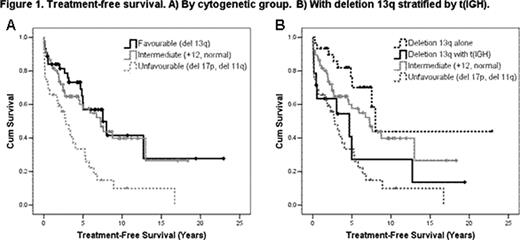Abstract
Abstract 2434
Recurrent cytogenetic abnormalities detected by FISH have prognostic significance in CLL patients (pts) [Dohner NEJM 2000]. While pts in unfavourable cytogenetic risk groups (deletion 17p, deletion 11q) consistently show poor overall (OS) and treatment-free survival (TFS), those in intermediate and favourable risk groups (trisomy 12, deletion 13q, normal FISH) are clinically heterogeneous. There remains a need to further refine these FISH prognostic categories to better risk stratify pts. Recently, IGH translocations [t (IGH)] have been increasingly reported in the literature and are suggested to portend a poor prognosis [Cavazzini BJH 2008]. We sought to determine the frequency of t (IGH) in CLL pts at our institution and determine their clinical significance in relation to other common FISH abnormalities, specifically the intermediate-favourable risk groups.
We reviewed all CLL pts referred for FISH analysis from 2006 onwards to Vancouver General Hospital (VGH), an academic quaternary-care referral centre and home of the Leukemia/BMT Program of BC. Since 2006, a commercially available FISH panel (Cytocell Ltd.) consisting of ATM, D13S19–25, TP53 DNA locus specific probes, chromosome 12 centromere probe, and an IGH breakapart probe was used for all CLL specimens. All patients were tested for t (11;14) and excluded if positive. Clinical and laboratory data was collected from an institutional CLL database. The primary endpoint was TFS, defined as time from diagnosis to primary therapy.
142 CLL pts had FISH performed at VGH between 2006–2009. Median age at diagnosis was 58 yrs (range, 35–85). The prevalence of FISH abnormalities was: 13 deletion 17p (9%), 20 deletion 11q (14%), 41 trisomy 12 (29%), 78 deletion 13q (55%), 37 t (IGH)(26%) and 28 IGH deletion (20%). At median follow-up of 6.9 yrs, 77 pts required CLL treatment (54%); 15 died (11%). Median time from diagnosis to FISH testing was 4.2 yrs (range, 0–22) and median time from diagnosis to therapy was 2.1 yrs (range, 0–17). 49 pts had FISH testing after initiation of therapy. Median TFS for the 142 pts was 5.3 yrs (range, 3.8–6.9); median OS 18.6 yrs. Analysis of the 37 pts with t (IGH) showed they were associated with intermediate-favourable risk cytogenetic abnormalities including trisomy 12 (n=6) and deletion 13q (n=19). The only pts with concomitant deletion 17p (n=1) or deletion 11q (n=5) had FISH testing done after initiation of therapy. When the impact of t (IGH) was assessed irrespective of other cytogenetic abnormalities, pts with t (IGH) did as well as those without; median TFS 4.9 vs. 5.9 yrs (P=0.92) and median OS 18.7 vs. 14.6 yrs (P=0.57) respectively. Next, pts were categorized by the Dohner hierarchy and grouped as follows: unfavourable (deletion 17 or deletion 11q, n= 32), intermediate (trisomy 12 or normal FISH, n=66), or favourable (deletion 13q, n=44). Median TFS for each group was 2.8 yrs, 7.2 yrs, and 7.5 yrs respectively (Figure 1A, P=0.001 across all groups). No significant TFS difference was found in pts with t (IGH) in unfavourable and intermediate risk cytogenetic groups (P=0.43 and P=0.45 respectively). In contrast, a significant difference in median TFS was seen in deletion 13q pts with coexistent t (IGH)(n=14) compared to those without (n=30), 4.7 yrs vs. 8.0 yrs respectively (P=0.027), and a trend towards worse median OS, 14.6 yrs vs. not reached (P=0.31). Pts with deletion 13q alone retained their good prognosis, while those with t (IGH) fell between intermediate and unfavourable risk groups (Figure 1B, P<0.001 across all groups). When only pts with FISH testing prior to therapy were examined, there remained a significant difference between those with deletion 13q and t (IGH)(n=10) vs. deletion 13q alone (n=24)(median TFS 4.7 yrs vs. not reached, P=0.039).
In this cohort, the presence of t (IGH) negatively impacted pts with deletion 13q, further stratifying this group into 2 separate prognostic entities. Importantly, the outcome of CLL pts with deletion 13q and coexistent t (IGH) was similar to those with intermediate-unfavourable cytogenetics. This may explain the clinical heterogeneity seen in pts with deletion 13q and lends further support to include this marker in routine FISH analysis. Further analyses of IGH abnormalities in this favourable risk cytogenetic group in a larger population are in progress to validate these results.
Treatment-free survival. A) By cytogenetic group. B) With deletion 13q stratified by t (IGH)
Treatment-free survival. A) By cytogenetic group. B) With deletion 13q stratified by t (IGH)
Toze: Hoffmann-La Roche: Honoraria, Research Funding; Genzyme: Honoraria, Research Funding; GlaxoSmithKline: Honoraria.
Author notes
Asterisk with author names denotes non-ASH members.


This feature is available to Subscribers Only
Sign In or Create an Account Close Modal